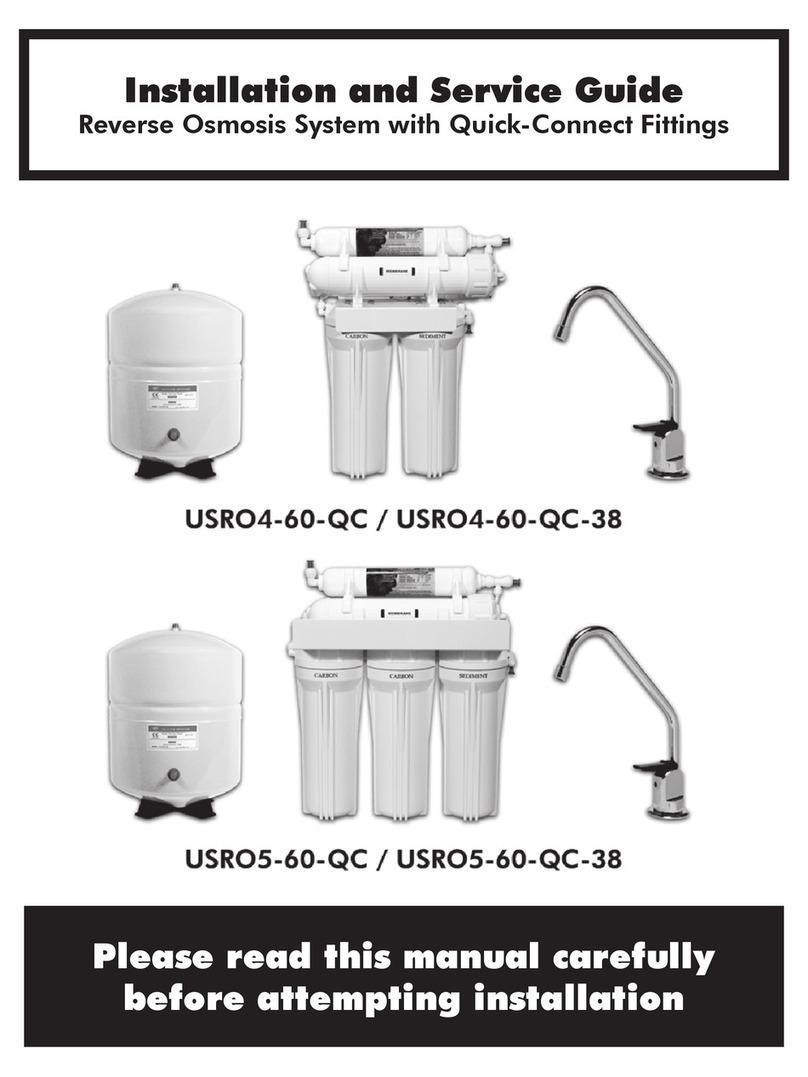
Your Reverse Osmosis (RO) System has been tested
to ensure it will operate correctly. The following periodic
maintenance is recommended so your system will provide
years of trouble-free service:
• Prelters (sediment) Once per year
• Prelter (carbon block(s)) Once per year
• RO Membrane Usually Every 2 years
• Postlter (carbon) Once per year
System Components
The following components make up your reverse osmosis
system:
Prelter #1 (sediment) Melt Blown Polypropylene lter
removes larger particles such as dirt, rust & sediment.
Prelter #2 (& 3 if applicable) 10 Micron Carbon Block
removes chlorine and chemical contaminants in the feed
water and protects the RO membrane.
Reverse Osmosis Membrane Thin Film Composite
Membranes reduces dissolved minerals, metals, and salts.
In this process, harmful compounds are separated by
the membrane from the water, and the contaminants are
ushed to the drain.
A coconut shell activated carbon postlter is provided for
a nal “polish” and to remove tastes, odors and to provide
great tasting water.
The RO module is the main component and holds the
prelters and membrane, and postlter. A bracket is
provided so they can be mounted under the sink or in a
basement.
Bladder tank holds RO puried water, ready to use.
Automatic shut-off valve closes when the storage tank is
full and shuts off the water supply to conserve water. The
valve activates when the tank pressure is 2/3 of the feed
pressure.
The RO Faucet is used to dispense puried water when
you want it.
Feed water saddle valve connects to the cold water line
to supply water to the RO system.
Wastewater saddle valve connects to the drain to remove
reject water from the RO system.
Tubing connects all RO components.
Quick-Connect ttings are used for necessary tubing
connections. These ttings connect by pushing the tube
into the tting past a slight resistance until the tube bottoms
out in the tting. Simply make a clean cut in your tubing
and gently push in the tubing until it will not go any further.
To ensure that your tubing has made a snug t, pull back
gently on the tubing; it should catch. Always check for leaks
to ensure a watertight connection. (see Figure 1)
Tools
The following tools may be necessary, depending on each
particular installation:
⅜” variable speed electric drill (2,500 RPM is best for
stainless steel); ⅛”, ¼” & ½” metal cutting bits
⅛”, ¼” & ½” Concrete drill bits (for porcelain sinks)
Phillips head screw driver
6” adjustable wrench
Teon tape & Plastic tubing cutter
Hammer & Center punch
System Location
Your RO system may be installed under a sink or in a
basement. Do not install unit where it would be exposed to
freezing temperatures. Connecting to an icemaker or other
remote location can also be considered if a connection can
be made without using more than 12” of tubing, otherwise
a delivery pump may be needed. Farther runs can be
attempted and a pump can be added later only if needed.
Guidelines for component placement are as follows:
Faucet should be placed on, or near the sink where
drinking/cooking water is normally required. A 2” at
surface is required to mount faucet if an existing hole is not
available. The thickness of the mounting surface should
not exceed 1¼” or a faucet extension (not supplied) will be
needed.
Bladder Tank maybe placed where it is convenient, within
ten feet of the faucet. Under the sink or in a nearby cabinet
or in basement rafters are excellent choices. Full tanks can
weigh more than thirty pounds; so make sure any shelving
used is secure. Bladder tank can be placed on its side or
upright.
RO Unit may be mounted on either side of the sink,
in the back of a cabinet, or in the basement. Mounting
the unit on the left or the right side of the cabinet under
the sink provides for easier access to the unit for future
maintenance.
A Self Piercing Valve is used to supply a feed water
connection to the RO unit. Locate this assembly as close
to the RO unit as possible. Connect to a portable, cold
water supply line only. A self-piercing valve can be used on
copper or chrome plated copper tubing, CPVC, & exible
gray riser tubes at least 3/8” in size. It should not be used
on ribbed, corrugated, reinforced plastic or steel braided
tubing. Ask your local dealer which alternatives can be
used in place of the self-piercing valve if one cannot be
installed under your sink.



























